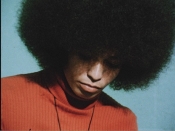 By Brian Lafferty
By Brian Lafferty
October 21, 2011 (San Diego) – The Black Power Mixtape 1967-1975 opens by saying it “doesn’t presume to tell the whole story of the Black Power Movement.” It further states that the purpose of the film is to show how the Black Power Movement was perceived by a few Swedish filmmakers. For me, nine times out of ten the first minute can make or break a film. The first minute in this documentary establishes the treatment afforded to this volatile, polarizing, and historically significant movement.
So don’t go in expecting to see the authoritative account of the Black Panther Movement, although it’s by no means a superficial one. Do go in expecting a punchy documentary that speaks in as high a volume as Martin Luther King Jr., Stokely Carmichael, and Eldridge Cleaver.
Congress passed the Civil Rights Act of 1964 but three years later vile racism and discrimination towards blacks remains rampant. In 1968 Martin Luther King Jr. is assassinated. Opposition to the Vietnam War brews while the newly formed Black Panther Party gains prominence, drawing the ire of F.B.I. Director J. Edgar Hoover, who viciously goes after it. In the early 1970s, Angela Davis is tried on specious accessory to murder charges. As the Vietnam War ends, a new kind of war plagues Harlem, the War on Drugs.
Robin Kelly, one of a number of people interviewed about the Black Power Movement for this documentary, says seeing the footage presents both an innocent and global perspective. He’s mostly right. The people filming it were outsiders. I see The Black Power Mixtape more as a tolerant perspective, supporting the Movement with a reasonable and persuasive voice.
As each year passed, I observed a certain evolution within the revolution. King was a strong advocate of nonviolent protests, which were instrumental in the Civil Rights Movement’s success. By 1967, the effectiveness of nonviolent protests was increasingly diluted and Stokely Carmichael argued for a militant approach. The Black Power Mixtape captures the transformation from nonviolence to militancy. When it gets to the War on Drugs, it becomes more peaceful.
The footage and the way it’s shot reflect this evolution. I doubt the filmmakers intended it that way but it’s a happy coincidence. The footage from 1967 to 1972 is mostly black and white film that looks like it was meticulously restored. It has urgent, revolutionary, and militant qualities, with its often-handheld camera and its numerous zooms. The filmmakers fully immerse themselves in the Black Power Movement, its politics, its protests, and these people’s lives.
The footage from 1973 to 1975 is in color and has apparently been given just as equal restoration as the black and white footage. The camera is mostly stationary and calm. The last segments of the film are relaxed, cool, and more reasoned. Harlem is gritty, seedy, and slummy.
Director Göran Olsson recruits numerous people, from singers to college professors, to discuss the Black Power Movement as the events play out on screen. It matters little that few of the people are high profile; the most notable names I recognized were Harry Belafonte and Melvin Van Peebles. Angela Davis, Bobby Seale, and Kathleen Cleaver (widow of Eldrige Cleaver) also speak, looking back on their roles in the movement.
Although at times it has the air of a big-screen DVD commentary, it works for several reasons. By not cutting away to the contemporary figures, it makes it easy to focus attention on the images, where it belongs. The commentaries provide a lot of historical context. They tell of the significance and influence of the events forty years later in a way that can’t be seen just by the footage itself.
The Black Power Mixtape made me feel thankful towards the people who had the foresight and courage to document this moment in time. Very few people would have had the guts to do it.
The Black Power Mixtape 1967-1975 is now playing at the Landmark Ken Cinema.
An IFC Films release. Director: Göran Hugo Olsson. Screenplay: Göran Hugo Olsson. Appearances: Stokely Carmichael, Eldridge Cleaver, Kathleen Cleaver, Bobby Seale, Huey P. Newton, Emile de Antonio, William Kunstler, and Angela Davis, Commentary: Erykah Badu, Harry Belafonte, Kathleen Cleaver, Angela Davis, John Forté, Kenny Gamble, Robin Kelley, Talib Kweli, Abiodun Oyewole, Melvin Van Peebles, Sonia Sanchez, Bobby Seale, Ahmir Questlove Thompson. 92 minutes. Unrated.
Brian Lafferty can be reached at brian@eastcountymagazine.org. You can also follow him on Twitter: @BrianLaff.











Recent comments